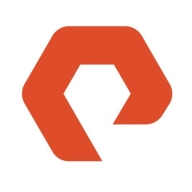


Red Hat Ceph Storage and IBM Cloud Object Storage both compete in the enterprise storage solutions category. IBM Cloud Object Storage holds the upper hand due to its advanced features and robust security, which justify its higher costs.
Features: Red Hat Ceph Storage provides excellent scalability and flexibility with integration into open-source ecosystems, making it adaptable for diverse deployments. It offers seamless integration with OpenStack and supports multiple storage types like block and object storage. IBM Cloud Object Storage features infinite capacity and strong data protection, making it ideal for sensitive transaction data. Its integration capabilities enable easy data movement between on-premises and cloud environments.
Room for Improvement: Red Hat Ceph Storage can improve in user interface simplicity, reducing complexity for new users. Enhanced support for hybrid cloud environments and more intuitive integration options would make it more competitive. IBM Cloud Object Storage could benefit from reducing initial costs and providing more customizability in data management. Improvements in usability for less technical users and streamlining its setup process would enhance its offering.
Ease of Deployment and Customer Service: Red Hat Ceph Storage allows flexible deployments with extensive community support but may pose challenges due to its complexity. IBM Cloud Object Storage offers a simpler deployment process with robust customer service through its established enterprise support channels, making it easier for enterprises to implement and maintain.
Pricing and ROI: Red Hat Ceph Storage is more cost-effective, primarily due to its open-source nature and lower setup costs, leading to faster ROI. IBM Cloud Object Storage, although requiring a larger initial investment, offers higher ROI potential through its advanced security features and reliability, making it a worthwhile option for businesses with stringent security requirements.
| Product | Market Share (%) |
|---|---|
| Red Hat Ceph Storage | 17.3% |
| Pure Storage FlashBlade | 5.7% |
| IBM Cloud Object Storage | 1.0% |
| Other | 76.0% |



| Company Size | Count |
|---|---|
| Small Business | 11 |
| Midsize Enterprise | 11 |
| Large Enterprise | 21 |
| Company Size | Count |
|---|---|
| Small Business | 3 |
| Midsize Enterprise | 2 |
| Large Enterprise | 4 |
| Company Size | Count |
|---|---|
| Small Business | 13 |
| Midsize Enterprise | 4 |
| Large Enterprise | 15 |
FlashBlade is the industry’s most advanced scale-out storage for unstructured data, powered by a modern, massively parallel architecture to consolidate complex data silos (like backup appliances and data lakes) and accelerate tomorrow’s discoveries and insights.
IBM Cloud Object Storage is a web-scale platform that stores unstructured data - from petabyte to exabyte - with reliability, security, availability and disaster recovery without replication.
We monitor all File and Object Storage reviews to prevent fraudulent reviews and keep review quality high. We do not post reviews by company employees or direct competitors. We validate each review for authenticity via cross-reference with LinkedIn, and personal follow-up with the reviewer when necessary.